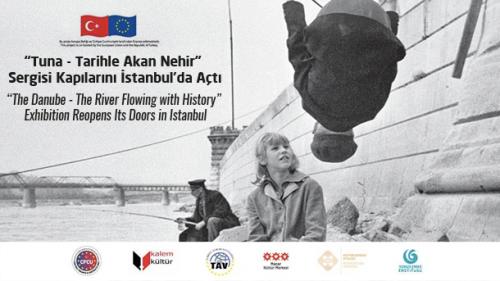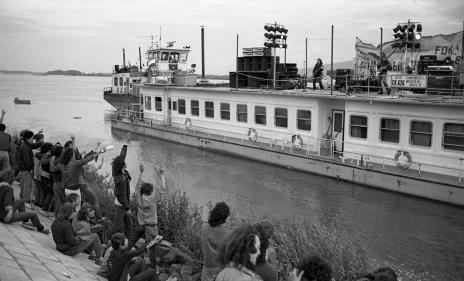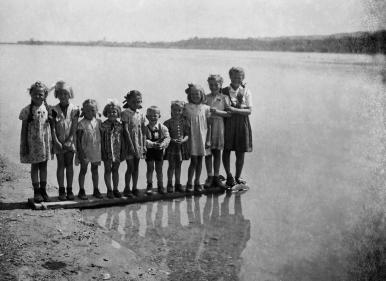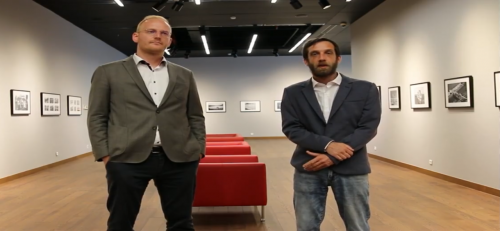"The Danube - The River Flowing with History" Exhibition Unveiled in Istanbul
The Hungarian Cultural Center in Istanbul has unveiled "The Danube - The River Flowing with History" exhibition at an online ceremony. The exhibition, held previously at the Hungarian Cultural Center in Bucharest, is organized within the framework of the "Diversity in Unity: Intercultural Dialogue Through the Waves of Danube," a project implemented as part of the EU-Turkey Intercultural Dialogue Programme.
The Hungarian Cultural Center in Istanbul performed the opening ceremony for "The Danube - The River Flowing with History" exhibition on Tuesday, July 7. The exhibition, held as part of the "Diversity in Unity: Intercultural Dialogue Through the Waves of Danube," an EU-Turkey Intercultural Dialogue Programme project, turns the spotlight on the last 100 years of the Danube.
WITNESSING EMPIRES
The Danube as a river originating in Germany and traveling through the Balkans had carved itself a special place in the archives of the Ottoman Empire, which had controlled the Balkan territories for a long time. "The Danube - The River Flowing with History" exhibition unearths the photographs documenting the last century of the Danube. |
The Danube as a river originating in Germany and traveling through the Balkans had carved itself a special place in the archives of the Ottoman Empire, which had controlled the Balkan territories for a long time. "The Danube - The River Flowing with History" exhibition unearths the photographs documenting the last century of the Danube. The exhibition showcases the analog photographs cherry-picked from Hungary's famous Fortepan Photography Archive, portraying the events, both happy and tragic, that occurred along the banks of Europe's second largest river, the Danube, during the last 100 years.
Hungarian Cultural Center Director Gabor Fodor delivered a keynote speech during the opening ceremony aired on the Institute's social media accounts, noting that the Hungarian Cultural Center has introduced digital programs during the pandemic.
|
This old photo showing people listening to a concert by the Danube river is among exhibition photos. |
"We have to proceed with online programs unfortunately due to the ongoing pandemic. The Hungarian Cultural Center will be open on working days and on Saturdays as was the case before the pandemic. Our exhibitions will be open for you. Our exhibition areas can be visited by up 10 people simultaneous in compliance with the normalization measures, such as using disinfectants and masks. We will be waiting for you physically in addition to our social media venues at the Hungarian Cultural Center," he said.
Vice Director and Cultural Attaché Balazs Szöllössy indicated, "Here, we have many photographs. Now, you can visit this exhibition physically. Here, we have more than 70 photographs. We are operating at the Hungarian Cultural Center in Istanbul. This exhibition was launched first at the Hungarian Cultural Center in Bucharest. Indeed, with this project, we promote many capitals in the Danube region of the European Union and Turkey", he said.
THE DANUBE AS A FAMILY ALBUM
Istvan Viragvölgyi, the exhibition's curator, attended the ceremony with an online link and described what the Danube meant to him as follows:
|
A group of children by the Danube. Soruce: Hungarian Cultural Center |
"The Danube: We usually liken it to time; although we see the river, the water changes constantly. In the same manner, even if we live in the current moment, moments flow continuously. But, of course, we cannot keep them in our hands. Photography, on the other hand, can consolidate both time and water for an eternity. There are numerous images of the Danube that my eyes have caught and that are kept in my mind. Those are the moments from the time when I had rowed a boat with my elder brother near the village of Szigetmonostor or washed the carpets near the dam for my grandmother living in the town of Paks, or ate fish soup while watching the Liberty Statue in Budapest, or swam with my nephews near the sand island of Göd. Those moments were not photographed, but when we look at Fortepan, which has become a collective family photo album for us all, the scenes which we never saw before, but which appear familiar turn into the friendly faces and events," he said.
AN ARCHIVE OF 130,000 PHOTOGRAPHS
Curator Istvan Viragvölgyi: The Fortepan Photography Archive was established in 2010 with 5,000 photographs as an archive collecting photographs taken before 1990, particularly from personal archives. The archive has grown constantly for 10 years, now having 130,000 photographs. |
Curator Viragvölgyi indicated that the Fortepan Photography Archive, from which the photographs on exhibition were taken, was established in 2010 with 5,000 photographs as an archive collecting photographs taken before 1990, particularly from personal archives.
"The Fortepan Photography Archive was established in 2010 with 5,000 photographs as an archive collecting photographs taken before 1990, particularly from personal archives. The archive has grown constantly for 10 years, now having 130,000 photographs. The archive works on a voluntary basis and anyone can download any photograph in any resolution and use it freely by citing the resource. The archive is a truly social information source, offered by the public for the public," he said.
CONNECTING ISTANBUL AND HUNGARY
Viragvölgyi : The name of the Fortepan Photography Archive is derived from Hungary's most popular negative film raw material. As a matter of fact, most of the photographs on display here had been shot using this negative film brand. During the production, the water from the Danube was used; thus, there was a connection between these photographs and the Danube. As for the connection with Istanbul, it is still possible to find usable Fortepan films at the photographer's shops in Sirkeci." |
Viragvölgyi stated that the name of Fortepan actually connects the Danube and Istanbul:
"The name of the Fortepan Photography Archive is derived from Hungary's most popular negative film raw material. As a matter of fact, most of the photographs on display here had been shot using this negative film brand. These films were produced in Vac, located 30 kilometers to the north of Budapest between 1932 and 2007. During the production, the water from the Danube was used; thus, there was a connection between these photographs and the Danube. As for the connection with Istanbul, it is still possible to find usable Fortepan films at the photographer's shops in Sirkeci."
EVERYONE WILL FIND SOMETHING PERSONAL
Calling on art lovers to look at the photographs, Viragvölgyi said, "Fortepan is really our common family album and you can find familiar and sweet moments in it. Have fun."
"The Danube - The River Flowing with History" exhibition will be open to visitors tomorrow and up to 10 visitors will be allowed simultaneously with the usual measures.












